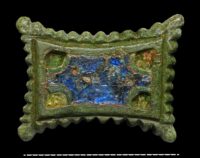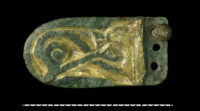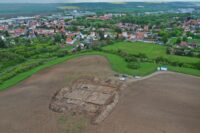 The remains of a church built in the 10th century by the first Holy Roman Emperor have been discovered under a cornfield near Eisleben, in Saxony-Anhalt, northeastern Germany. State archaeologists have been excavating the site of the royal palace of Helfta built by Holy Roman Emperor Otto I west of modern-day Eisleben.
The remains of a church built in the 10th century by the first Holy Roman Emperor have been discovered under a cornfield near Eisleben, in Saxony-Anhalt, northeastern Germany. State archaeologists have been excavating the site of the royal palace of Helfta built by Holy Roman Emperor Otto I west of modern-day Eisleben.
Since digs began in May, the team has unearthed the foundation walls of a classic three-aisled cruciform basilica about 98 feet long and 66 feet wide with a transept and semicircular apse on the east end. Church-related artifacts found so far include a Romanesque bronze crucifix with enamel, a prestigious object made in Limoges in the 13th century, and a large piece of a church bell.
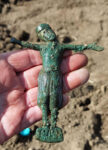 The church was founded around 968 by Holy Roman Emperor Otto the Great who had moved to Rome two years earlier to take a more hands-on approach in his unruly relations with the papacy and widen his sphere of influence in Italy. Building large, showy churches in Germany, especially in his ancestral duchy of Saxony, was part of his program to establish himself as Emperor of the Romans and the newly-minted Holy Roman Empire as the true papal-approved successor to the Roman Empire. (The Byzantine emperor begged to differ.)
The church was founded around 968 by Holy Roman Emperor Otto the Great who had moved to Rome two years earlier to take a more hands-on approach in his unruly relations with the papacy and widen his sphere of influence in Italy. Building large, showy churches in Germany, especially in his ancestral duchy of Saxony, was part of his program to establish himself as Emperor of the Romans and the newly-minted Holy Roman Empire as the true papal-approved successor to the Roman Empire. (The Byzantine emperor begged to differ.)
Historian Thietmar von Merseburg wrote in his early 11th century chronicle that the church at Helfta was dedicated to Saint Radegund, a 6th century Thuringian princess who dumped her husband Merovingian Frankish King Chlothar I in favor of an ascetic religious life. Theitmar also recorded that Otto the Great had been personally present when the church was inaugurated.
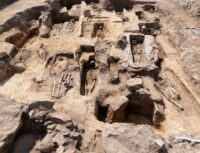 More than 70 graves including brick and stone tombs from the 10th through the 15th centuries have been found inside the church precinct and in the adjacent cemetery. Objects recovered include a gilded belt buckle, coins, knives and several enameled bronze brooches. which was the final resting place for many of the region’s elite. Thietmar’s account describes one such burial. It was his own relative Count Werner von Walbeck, whose remains were transported from Walbeck to be buried in the churchyard in 1014. The body was in an advanced state of decomposition, so Thietmar had the entrails removed and buried in the cemetery in lieu of the fully intact corpse.
More than 70 graves including brick and stone tombs from the 10th through the 15th centuries have been found inside the church precinct and in the adjacent cemetery. Objects recovered include a gilded belt buckle, coins, knives and several enameled bronze brooches. which was the final resting place for many of the region’s elite. Thietmar’s account describes one such burial. It was his own relative Count Werner von Walbeck, whose remains were transported from Walbeck to be buried in the churchyard in 1014. The body was in an advanced state of decomposition, so Thietmar had the entrails removed and buried in the cemetery in lieu of the fully intact corpse.
Martin Luther was born and died in Eisleben, and it was the Reformation he sparked that cause the church’s ultimate destruction. For 500 years it dominated the landscape and religious life of the area. Come the fury of the Protestant Reformation, its walls were torn down to its foundations and its very location obliterated from the record.
The excavation of the site will continue until early September and will widen the dig area to the area around the church. Archaeologists hope to unearth remains of the settlement and fortifications the grew around the Ottonian royal palace.
